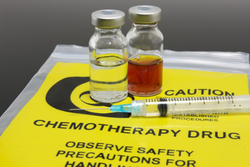
A new gentler chemotherapy drug in the form of nanoparticles has been designed by Northwestern Medicine® scientists to be less toxic to a young woman’s fertility but extra tough on cancer. This is the first cancer drug tested while in development for its effect on fertility using a novel in vitro test.
The scientists designed a quick new in vitro test that predicts the toxicity of a chemotherapy drug to fertility and can be easily used to test other cancer drugs in development as well as existing ones. Currently the testing of cancer drugs for fertility toxicity is a time and resource intensive process.
“Our overall goal is to create smart drugs that kill the cancer but don’t cause sterility in young women,” said Teresa Woodruff, PhD, a co-principal investigator of the study and chief of fertility preservation at Northwestern University Feinberg School of Medicine. The paper was published March 20 in in the journal PLOS ONE.
The scientists hope their integration of drug development and reproductive toxicity testing is the beginning of a new era in which chemotherapy drugs are developed with an eye on their fertotoxity (fertility toxicity). As cancer survival rates increase, the effect of cancer treatments on fertility is critically important to many young patients.
Woodruff and Thomas O’Halloran, also a co-principal investigator and director of the Chemistry of Life Processes Institute at Northwestern, are a wife and husband team who developed and tested the drug.
Their intersecting interests – hers in fertility preservation, his in cancer drug development – percolated over dinner conversations and sparked the collaboration.
O’Halloran also is the associate director for basic sciences research at the Robert H. Lurie Comprehensive Cancer Center of Northwestern University; Woodruff is a member of the Lurie Cancer Center and the Thomas J. Watkins Memorial Professor of Obstetrics and Gynecology at Feinberg. Richard Ahn, now a fourth-year medical student at Feinberg in the MD/PhD program and the study’s lead author, coordinated the preclinical testing of the nanobins as a graduate student in O’Halloran’s lab.
A Tiny Trojan Horse
The chemotherapy drug, arsenic trioxide, is packed into a very tiny Trojan horse called a nanobin. The nanobin consists of nano-size crystalline arsenic particles densely packed and encapsulated in a fat bubble. The fat bubble, a liposome, disguises the deadly cargo – half a million drug molecules.
“You have to wallop the tumor with a significant dose of arsenic but at the same time prevent exposure to normal tissue from the drug,” said O’Halloran. The fat bubble is hundreds of times smaller than the average human cell. It is the perfect size to stealthily slip through holes in the leaky blood vessels that rapidly grow to feed tumors. The local environment of the tumor is often slightly acidic; it is this acid that causes the nanobin to release its drug cargo and deliver a highly effective dose of arsenic where it is needed.
The scientists show that this approach to packaging and delivering the active drug has the desired effect on the tumor cells but prevents damage to ovarian tissue, follicles, or eggs.
While the drug is gentle on fertility, it is ferocious on cancer. When tested against lymphoma, it was more potent than the drug in its traditional free form.
“The drug was designed to maximize its effectiveness, but reduce fertotoxicity,” said O’Halloran, also the Morrison Professor of Chemistry in the Weinberg College of Arts and Sciences at Northwestern. “Many cancer drugs cause sterilization, that’s why the reproductive tract is really important to focus on in the new stages of drug design. Other body systems get better when people stop taking the drug, but fertility you can’t recover.”
Arsenic trioxide was approved a few years ago for treating some types of blood cancers such as leukemia in humans, but O’Halloran thinks the arsenic trioxide nanobins can be used against breast cancer and other solid tumors. In his previously published preclinical research, nanobins were effective in reducing tumor growth in triple-negative breast cancer, which often doesn’t respond well to traditional chemotherapy and has a poor survival rate.
Quick Test for Fertility Toxicity
Woodruff was able to show early effects of the drug on fertility by using an in vitro follicle culture and a quick, simple new test she developed. She compared the fertotoxicity of the nanobin and free drug and found the nanobin was much less toxic to female fertility than the free drug in the experimental model.
“The system can be adapted very easily for any cancer drug under development to get an early peek under the tent,” said Woodruff, also the Thomas J. Watkins Memorial Professor of Obstetrics and Gynecology at Feinberg. “As this new drug goes forward in development, we can say this is a good drug for young female cancer patients who are concerned about fertility.”
The information gained from the toxicity test will help inform the treatment decisions of oncologists and their young female cancer patients to improve their chances of creating a future family.
“They may prescribe less toxic drug regimens or refer them to specialists in fertility preservation,” Woodruff said.
The research was supported by grants RL1HD058295, PL1EB008542 and T32 HD07068 from the National Institute of Child Health and Development of the National Institutes of Health; grants U01CA151461, U54CA119341 and P30CA060553 from the National Cancer Institute of the National Institutes of Health; and grant BC073413 from the Department of Defense.






